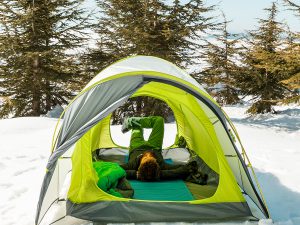
IMPROVE YOUR MOUNTAINEERING PERFORMANCE THROUGH BETTER RECOVERY
- July 31, 2020
- 0
The most underestimated component of a training plan is the recovery phase. Fatigue is your body’s feedback to you about your training. Usually the body’s reaction to stress is to become weaker, which is why you should start thinking about a sufficient recovery period. What should you do during this period? Is it only about resting? Is it a reduction of volume and intensity?

Recovery time:
When you feel tired after a heavy workout, intramuscular glycogen restoration usually takes between eight to seventy-two hours, so your next heavy workout should be delayed for about two days.
Endurance training has a big effect on the energy stored in the muscles; well-trained athletes have three times more intramuscular glycogen stored than untrained people. So, the better trained the person is, the harder and longer he can last.
A short endurance workout should require between eight to twenty-four hours for a full recovery, while a long endurance workout should require between twenty-four to forty-eight hours for a full recovery. High intensity workouts require the longest recovery periods, usually from two to three days before taking the same load again.
Eating within twenty minutes of finishing your workout will reduce the time needed for recovery.
How to enhance recovery:
Athletes who are crossing their limits with their training should consider focusing more on recovery in their training plan. These steps can speed up the time of the recovery process.
1- Diet:
Athletes should always link their diet plans to the recovery process. The harder the exercise, the faster the depletion of their glycogen stores. Consider taking some calories as soon as you finish your workout in order to start repairing the damage and restoring the glycogen. Start by consuming 200 calories within twenty minutes of finishing your workout, with a ratio of 3:1 carbohydrates to proteins. This can sometimes decrease your recovery by days.

2- Sleep:
Everyone knows the effect of a goodnight sleep, but it’s the quality that makes the difference. Most of the rebuilding and the damage repairing is accomplished during the rapid eye movement phase (REM). This phase occurs in intervals of 90 to 120 minutes and it involves a state of very deep relaxation. Anything that disrupts this phase is going to affect the recovery period.
3- Massage:
Endurance activities involves a big number of repetitions for the same movements, resulting in acute inflammation of the involved muscles, giving the feeling of stiffness and soreness. Expert massage will increase the blood flow in tired muscles, speeding the replenishment of nutrients and accelerating the recovery.
Sometimes, self-massage could be effective; athletes can use balls and foam rollers that are easy to use and can give more direct pressure on the sore areas of the body. The athlete can feel the pain and can control the pressure and the positioning accordingly.
4- Reducing life stressors:
Your body responds to stress in the same way regardless if it’s coming from a workout, or from life’s difficulties. Athletes can use relaxation techniques such as meditation. The more they decrease daily stress, the more they can handle the stress of the workouts.

5- Recovery workouts:
Very low intensity workouts have a powerful restorative effect, but the intensity should feel very easy. Usually, these workouts fall in zone 1 for athletes and zone 2 for the less trained persons.
Athletes who want to keep their sessions close could use this method; they should alternate the type of the exercises, for example, swimming can release the stress from the legs, or even a walk could be useful to speed up the recovery. Always keep in mind that light exercises are always better than staying on the couch all day long.
Article photos: Haig Melikian
https://www.facebook.com/HikewithHaig/
https://www.instagram.com/whereishaig/
PREPARED BY MARIO FARES – CERTIFIED PERSONAL TRAINER, NCSF
INSPIRED BY THE PHILOSOPHY OF THE UPHILL ATHLETES
SOURCE: TRAINING FOR THE UPHILL ATHLETE, A MANUAL FOR MOUNTAIN RUNNERS AND SKI MOUNTAINEERS











